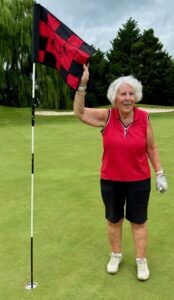Rehoboth Beach Country Club hosts Williamson Cup
August 16, 2024

The winning team from Washington Metropolitan Golf Association (left to right): Jack Hartman, Patrick Pritsios, Tommy Sharps, and Oliver Clark.
Forty junior golfers from ten golf associations representing several northeastern states and two Canadian provinces competed in the Williamson Cup at Rehoboth Beach Country Club Aug. 13.
The two-round, 36-hole tournament celebrated its 60th anniversary since its establishment by A. Fred Williamson, of Winged Foot and the USGA’s Executive Committee.
RBCC Director of Golf Pat Mastrian said, “It’s great to see our club continue to support junior golf. Having the Williamson Cup here shows the club’s continuing commitment to growing the game.”
Cup trustee Joe Loparco said using a team format was perhaps the greatest contribution the tournament makes to amateur golf. “Williamson cup is the oldest continuing team event in the United States.”
The Cup came to the Cape Region once before when Kings Creek CC hosted in 2001. The host association makes the site arrangements for its year in the rotation. Mastrian said Laura Heien, the longtime DSGA/GAP staffer, reached out to RBCC a few years ago. The club’s board readily agreed to be this year’s host.
Loparco said, “We’re always looking for high-quality venues. It’s a big attraction for the kids. We’ve been blessed over the years with numerous high-quality clubs [such as] Oak Hill and Saucon Valley, so it’s a real who’s who list. The pedigree of the Williamson Cup plays into our ability to get them.”
Four players from each association play two 18-hole medal rounds. The highest team score from each round is cut, making the team total the best six rounds for the day.
There is no minimum age limit for participants, but none can be 19 by the day of the tournament. Loparco said, “We’ve had many 13-year-olds that have held their heads high.”
The squad from Washington Metropolitan Golf Association won this year’s Cup, with a combined 12-under-par total.
The other teams and their order of finish were as follows: (2) Syracuse District Golf Association, (3) Rochester District Golf Association, (4) Western Pennsylvania Golf Association, (5) Delaware State Golf Association, (6) Golf Association of Philadelphia, (7) Metropolitan Golf Association, (8) Buffalo District Golf Association, (9) Golf Ontario, and (10) Golf Quebec.
Jack Hartman of Washington Metropolitan won medalist honors with his 12-under par performance, one stroke ahead of Noah Wallace, a multiple Maryland high school state champion representing the DSGA. Hartman’s teammates were Tommy Sharps, Oliver Clark, and Patrick Pritsios.
With the 2022 merger of the DSGA with GAP, this is the last year for DSGA juniors to field their own team. They remain eligible to join Team GAP for future Cup tournaments.
Cape Region golfers represented at DSGA summer tournaments
Congratulations to Ryan Rucinski of Wilmington for his victory Aug. 13 at the 59th Delaware Open.
The former Salesianum standout is an assistant pro at Wilmington Country Club. He beat multiple Open winner Zac Oakley by a single stroke in the two-day 54-hole contest.
Past Delaware Open winner Michael Chanaud of Peninsula Golf & Country Club performed best among the Cape Region golfers in the tournament, finishing seventh. Teaching pro Chris Krueger of Kings Creek Country Club, another past Open winner, tied for 14th, with Heritage Shores’ Josh Covey coming in 30th.
Cape Region golfers also played in the 9th Delaware Super-Senior Championship, held Aug. 5-6 at Plantation Lakes Golf & Country Club in Milford and won by Tom Humphrey of Wilmington.
In the gross category, Dean Pettyjohn of Mulligan’s Pointe finished seventh, with fellow member Scott Kimmel one stroke back and tied for 8th.
Other local members and their gross finish included Steven Kaminskey of The Rookery (T-13), John Cech of Rehoboth Beach CC (T-15), Tim Gallagher of The Rookery (17), and Stephen Lyons (T-18).
Matt Neitzey of Peninsula Golf & Country Club won the net category. Wallace (Pete) Townsend of Mulligan’s Pointe tied for third. Fellow Mulligan’s member Dean Pettyjohn tied for fifth with Jim Hutchins, the husband of Cape Henlopen High School golf team assistant coach Lisa Hutchins.
Another Rookery ace
Congratulations to Susan Scaglione for her hole in one on Aug. 7 at The Rookery during the club’s 18-Hole Ladies league competition.

Susan Scaglione
The Rehoboth Beach resident used her driver for her 120-yard ace on the 14th hole.
Local club competition results
The Kings Creek CC Ladies 9-Hole League played a 1 Best Ball of 4 game Aug. 13, in two flights.
Donna Deely, Kara Bourdreau, Deb Hinderer, and Beth Andrews won the first flight. Linda Outlaw, Margie Moore, Beth Cohen, and Tracy Gordon tied for second with Denise Sills, Marty Jaxheimer, Tish Brey, and Holly Clark.
Sandy Neverett, Deb D’Orazio, Kaye Allison, and Marie Murray won the second flight. Lesley Corydon, Deb Chase, Prabha Karapurkar, and Terry Barrera finished second.
The Mulligan’s Pointe Ladies League played a Crier’s Tournament Aug. 13, in two flights.
Maxine Ansbach won the first flight, with Diane Braver in second and Ann Reed in third.
Tammy Findlay won the second flight, followed by Kathy Hudak in second and Joann Foster in third.
The Kings Creek CC Ladies 18-Hole league played an individual stroke game through challenging wet conditions Aug. 8.
Lisa Smith won first place gross, with Jen Flinchbaugh winning first net. Darci Whitehead finished second net.

